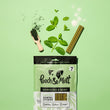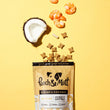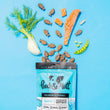FREE UK DELIVERY ON ORDERS OVER £39.99
Yes, rawhide is a risk-heavy chew for a dog.
This old-school dog treat is now seen as pretty controversial - in fact, at Pooch & Mutt we aren’t fans of rawhide at all.
Rawhide has been popular for one big reason; because dogs love to chew.
Chewing is more than just a habit for a dog, it actually releases endorphins, keeping them relaxed and content. This is why a dog with a tasty bone or chew toy is an age-old image we all recognise.
So what’s the problem with rawhide? What are the dangers of giving rawhide to a dog, and is there something else you can give your pooch to chew on instead?
Read on, because in this article, we’ll answer all the tricky questions you might have about whether rawhide is bad for dogs and offer some brilliant long-lasting chew alternatives.
Plenty of dogs chew on rawhide - it has been a popular dog product for a long time - but recently, dog owners are seeking out alternatives. It’s become somewhat of a controversial product, not only due to its chemical-heavy production but the risks that come from a dog ingesting it.
Here are some of the biggest reasons rawhide is considered a risky treat to give to your dog.

Whether to avoid giving rawhide to your dog is a personal choice, but if you’re asking us at Pooch & Mutt - yes, you should avoid it! Rawhide is an old-school dog product, and we believe dog owners should switch to the safer alternatives to rawhide now available.
That said, if you still want to give rawhide to your pooch, you should supervise every chewing session to make sure they don’t break or ingest it.
If your dog has eaten rawhide, you’re right to be somewhat concerned. The size of the swallowed piece will have some impact on what happens next, but even a small piece could have dangerous, small splinters or shards, so the best thing to do is call your vet for advice.
The most likely occurrence is that your dog may develop a stomach ache and have trouble passing it, but there is also the risk of intestinal blockage or bowel obstruction. In the worst case, this can be fatal for a dog. A vet will know the best course of action.
We thought you’d never ask! There are excellent alternatives to rawhide available - long-lasting chews that, unlike rawhide, are non-toxic and therefore fine for a dog to consume over time.
The best rawhide alternatives contain natural ingredients, and are processed gently, without any of the toxic preservatives and chemicals.
100% Cod Fish Hide Chew
Our all-natural fish skin hide is made of 100% gently rolled cod skin. It’s not only safe for a dog to eat, it’s nutritious; high in omega 3 and 6 (essential for healthy skin and coat, as well as strong nails, boosted immune system and improved cognitive function), a great source of collagen and protein, and it improves joint health and mobility in dogs.
Calming Fish Hide Chew
Similar to our 100% Cod Chew, this calming, long-lasting chew for dogs contains a smidge of chamomile, to give your dog an extra shot of calm with their chew session (as well as all the nutrients listed above). It’s also gently rolled using zero toxic chemicals or preservatives. Here’s some more in-depth info about our fish hide chews compared to rawhide.
Dental Chews for dogs
If you’re looking for a shorter-term chew that’s great for your pooch’s teeth, you could give your pooch a tasty dog dental stick to gnaw on. We have a range of delicious dental chews for dogs infused with flavours they go mad for; such as chicken and spirulina, or tasty peanut butter.
Note: Though our fish hide chews are safe for dogs to eat, we still recommend you supervise your pooch every time they’re enjoying a chewing session. FAQs Here are the answers to any final questions you might have about the risks of rawhide. Remember, you can always get in touch if you have any others!
This depends on the vet of course, but generally, vets will often make dog owners aware of the risks associated with rawhide: that they can cause a dangerous bowel obstruction or blockage if ingested, that dogs may react badly to the toxic chemicals used in rawhide’s production, and they might pose a choking hazard.
Vets will only recommend rawhide due to the positive effects of chewing, so a natural long-lasting chew for dogs is a great alternative to rawhide.
You might know that dogs will spend hours chewing on rawhide, but what exactly is it? Let’s get into more detail about what rawhide is made of and how it’s produced...
Rawhide is basically the dried-out skin of an animal, such as a cow or horse. It is a waste product of the meat industry - not intended for a dog’s consumption, but just for chewing.
Rawhide can be formed into many shapes, such as a bone, strip or twist, and basically looks and feels like a solid chew.
This is where the confusion comes in when it comes to commercial rawhide - it’s marketed as something a dog might eventually eat, when it’s not really safe for a dog to consume any of it.
The process of making rawhide is another reason why it’s deemed controversial. Making rawhide involves a very aggressive process of drying out, colouring and preserving, which requires a lot of strong chemical products.
You may have guessed this, but there’s a risk that the chemicals and preservatives in your dog’s rawhide will transfer to your dog’s digestive system while they’re chewing on it. These toxic substances can cause all kinds of side effects in your dog, from stomach upsets to allergic reactions.

Yes - if your dog has a strong bite, or the rawhide they’re chewing on is particularly hard, there is the risk that rawhide can break a dog’s teeth.
This depends on your pooch, their health condition and size. In general, it should take no longer than a day or two for your dog to pass an ingested rawhide. Keep a close eye on your dog’s behaviour, and take them to a vet if you believe they may have swallowed rawhide and not passed it.
You would need to check the packaging of the particular rawhide you’ve given to your pooch, as all rawhide products vary. The thing is, dogs shouldn’t be ingesting rawhide at all - they’re not intended as a consumable product but more of a chew toy. There isn’t any nutritional value in a commercial rawhide, unlike our long-lasting fish chews.
Just as we don’t recommend giving rawhide to dogs, we don’t suggest giving a rawhide to a puppy, either. They have small, developing teeth, and while chewing is very beneficial for them, choosing a natural, non-toxic dog chew is much safer.
If you’re convinced it’s time to opt for a rawhide alternative - take a look at our natural fish skin chews. They’re safe for dogs to eat and packed full of nutrients, so your dog can enjoy a supervised chew session without causing you any worries at all.





Never miss a treat!
Subscribe to our newsletter and get blog articles amongst other treats delivered to your inbox







Comments (2)
Hi, I have been looking for alternative treats for our dogs, as I have not given them rawhide for a number of years now. However, your long lasting fish hide chews should not be marked as long-lasting, as my dogs chew them in less than five minutes.
Hi Vicky,
Thank you so much for this valuable feedback! As every pooch is different where some are more of a ‘chewer’ than others, how quickly our Fish Hide Chews are consumed can vary. Although, they are designed to be longer lasting in comparison to alternative products. We do however really appreciate this feedback and will be sure to get this passed on :)
Leave a comment